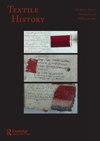路易莎·埃尔德顿和丽贝卡·莫里尔主编,《维生素T:当代艺术中的线和纺织品》
IF 0.1
2区 社会学
0 HUMANITIES, MULTIDISCIPLINARY
引用次数: 1
摘要
精装本《维他命T》是一本百科全书式的全球调查,收录了100多位艺术家,这些艺术家是由艺术界的专业人士——评论家、策展人和博物馆馆长——挑选出来的,他们的作品涉及线、缝纫和纺织品。虽然这本书很贵,但它有一个诱人的封面,华丽的彩色插图,珍妮勒·波特写的非常通俗易懂的介绍,里面充满了简明的传记信息。对于纺织历史学家来说,文本和传记插页的范围可能有限得令人沮丧,但对投资者来说,这是一个有用的目录。这本书由编辑路易莎·埃尔德顿和丽贝卡·莫里尔监督,他们在序言中(第9页)陷入了一个困扰纺织艺术领域许多作家和理论家的困境。一方面,《维生素T》中包含的许多作品不符合任何预先确定的材料、技术或媒介特定学科的分类。它们介于绘画、雕塑和装置之间。事实上,许多艺术家使用各种编织、打结、刺绣和针织的方法,并使用了更多通常与纺织品制作无关的材料——麻袋、塑料、木材、橡胶——以避免被归类。鉴于此,正如编辑们所承认的那样,这本书的副标题“当代艺术中的线和纺织品”实际上表明,它的范围远远小于它的内容。事实上,维他命T试图提供多元化的选择,矛盾的是,它提供的不过是一个快速变化的快照,反映了进入一个非常特殊的艺术世界市场的可接受的新层次结构。Jenelle Porter对Vitamin t的介绍值得一读。作为美国波士顿ICA的高级策展人,Porter曾负责策划2014年的调查展览“纤维:雕塑1960年至今”。在波特看来,这可以追溯到20世纪60年代纤维艺术的革命,这十年试图模糊艺术和工艺之间的界限。二战后,“纤维艺术”一词被大多数美国策展人和艺术史学家用来描述艺术家-工匠的作品,二战后“艺术织物”的设计和生产急剧增加。20世纪50年代,随着工艺艺术家的贡献得到越来越多的认可——不仅在纤维方面,而且在粘土和其他媒介方面——越来越多的编织者开始将纤维粘合成无功能的形式,作为艺术品。正如波特在《维生素T》和《纤维》中所概述的那样,艺术界长期以来一直对以纤维为基础的艺术家和他们的作品抱有偏见。纤维制品通常在历史上被认为是女性化的,带有亲密和家庭生活的内涵,被降级为工艺领域,远离美术的行列。波特主张将纤维定位得更接近于自20世纪60年代以来推动抽象艺术形式的探索,波士顿的目录介绍了该领域大量最有影响力的艺术家,其中大多数是在纽约以外工作的美国或欧洲白人女性。有些人,如奥尔加·德·阿马拉尔和安妮·威尔逊,也包括在维生素T中,尽管后者包括许多英国和美国的黑人从业者,这是受欢迎的。一个著名的例子是住在哈莱姆区的桑福德·比格斯(Sanford Biggers),他长期以来一直着迷于布料,尤其是来自加纳的“非洲”布料,他的作品与欧洲有史以来第一本出版的关于非洲艺术的论文有关。纤维艺术运动可能缺乏主流运动的批判性分析:英国的《工艺》杂志(Craft)报道了纤维艺术,但美国的《艺术论坛》(Artforum)却没有,比如《书评》(Book Reviews)本文章由计算机程序翻译,如有差异,请以英文原文为准。
Louisa Elderton and Rebecca Morrill, eds, Vitamin T: Threads and Textiles in Contemporary Art
A hardback volume, Vitamin T is an encyclopaedic, global survey of more than 100 artists, chosen by art world professionals — critics, curators and museum directors — for their work with threads, stitching and textiles. Though an expensive purchase, it has a seductive cover, lavish colour illustrations, a very accessibly written introduction by Jenelle Porter and is filled with concise biographical information. For textile historians, the texts and biographical inserts may prove frustratingly limited in scope, but it is a useful catalogue for investors. The book is overseen by editors Louisa Elderton and Rebecca Morrill who get tangled up, in the Preface (p. 9), in a dilemma that haunts many writers and theorists in the textile arts field. On the one hand, many of the works included in Vitamin T do not fit any predetermined classification of material, technique or medium-specific discipline. They fall somewhere between painting, sculpture and installation. Indeed, many of the artists utilise various practices of weaving, knotting, embroidery and knitting, and an expanded range of materials not normally associated with the making of textiles — burlap, plastic, wood, rubber — and so avoid being pigeonholed. Given this, as the editors admit, the book’s subtitle, Threads and Textiles in Contemporary Art, actually suggests a scope far narrower than its contents. In fact, by attempting to be pluralistic in choice, Vitamin T paradoxically offers no more than a fast-moving snapshot of a new hierarchy of acceptable entries into a very particular art world market. It is worth reading Jenelle Porter’s introduction to Vitamin T. Previously senior curator at ICA Boston, USA, Porter was responsible for curating the 2014 survey show, Fiber: Sculpture 1960–Present. This traced, in Porter’s view, a revolution in fibre art that happened during the 1960s, a decade that attempted to blur the lines between art and craft. The term ‘fibre art’ came into use by mostly American curators and art historians to describe the work of the artist-craftsperson following the Second World War, which saw a sharp increase in the design and production of ‘art fabric’. In the 1950s, as the contributions of craft artists became more recognised — not just in fibre but also in clay and other media — an increasing number of weavers began binding fibres into non-functional forms as works of art. As outlined by Porter in both Vitamin T and Fiber, the art world has long held a bias against fibre-based artists and their work. Often historically gendered feminine, carrying connotations of intimacy and domesticity, fibre compositions were relegated to the realm of craft, far from the ranks of fine art. Porter staked a claim for positioning fibre more firmly proximate to the explorations that have propelled abstract forms of art since the 1960s, and the Boston catalogue profiled a significant number of the field’s most influential artists, most of whom were white American or European women operating outside New York. Some, like Olga de Amaral and Anne Wilson, are also included in Vitamin T, though the latter includes a number of Black British and American practitioners, which is to be welcomed. One notable example is Sanford Biggers, based in Harlem, who has long been fascinated with cloth, especially ‘African’ cloth from Ghana, and whose work connects to Europe’s first-ever published treatise on African art. The fibre art movement may have lacked the critical analysis that attended mainstream movements: art in fibre was covered by Craft magazine in England but not Artforum in the USA, such was Book Reviews
求助全文
通过发布文献求助,成功后即可免费获取论文全文。
去求助
来源期刊

TEXTILE HISTORY
HUMANITIES, MULTIDISCIPLINARY-
CiteScore
1.00
自引率
0.00%
发文量
0
期刊介绍:
Textile History is an internationally recognised, peer reviewed journal and one of the leading publications in its field. It is viewed as an important outlet for current research. Published in the spring and autumn of each year, its remit has always been to facilitate the publication of high-quality research and discussion in all aspects of scholarship arising from the history of textiles and dress. Since its foundation the scope of the journal has been substantially expanded to include articles dealing with aspects of the cultural and social history of apparel and textiles, as well as issues arising from the exhibition, preservation and interpretation of historic textiles or clothing.
 求助内容:
求助内容: 应助结果提醒方式:
应助结果提醒方式:


